- Home
- /
- Solutions
- /
- Data Management
- /
- Re: SCHEDULING SAS DATA MANAGEMENT STUDIO JOBS
- RSS Feed
- Mark Topic as New
- Mark Topic as Read
- Float this Topic for Current User
- Bookmark
- Subscribe
- Mute
- Printer Friendly Page
- Mark as New
- Bookmark
- Subscribe
- Mute
- RSS Feed
- Permalink
- Report Inappropriate Content
Hi ,
I am working on sas data mangement studio and created a job for standardizing the data.Now i need to schedule the job in timeline basis(weekly).I am having sas data management server , and no sas web studio and web server .can anyone kindly help on this .
Thanks in advance.
Accepted Solutions
- Mark as New
- Bookmark
- Subscribe
- Mute
- RSS Feed
- Permalink
- Report Inappropriate Content
Sandeep,
As LinusH mentioned you can use scheduling software of your choice. There is not a job scheduler that ships with DM Studio or DM Server. I use the default scheduler for Windows or CRON for UNIX. The executable is located here (for my install):
C:\Program Files (x86)\DataFlux\DMStudio\studio1\bin>
The command you should execute is dmpexec which takes the following arguments:
usage: dmpexec [options]
options:
-c <file> read configuration from <file>
-j <file> execute job in <file>
-l <file> write log to <file>
-i <key>=<value> set input <key> to <value>
-o <key>=<value> set option <key> to <value>
-b <key>=<value> set job option <key> to <value>
-a authenticate using Authentication Server
Your scheduler should reference a script which resembles this:
"C:\Program Files (x86)\DataFlux\DMStudio\studio1\bin\dmpexec.cmd" -j "DM_JOB_NAME.djf" -l "LOG_FILE.log"
-shawn
- Mark as New
- Bookmark
- Subscribe
- Mute
- RSS Feed
- Permalink
- Report Inappropriate Content
Not a user myself, but from the documentation, I think that you define your jobs in Visual Process Orchestration.
Those flows can be executed from within Data Management Server, or by an external command, which I believe you can execute from the scheduling SW of choice.
I don't think that there exist any ready to use interface from within the product to an external scheduler, you probably need to do this manually.
- Mark as New
- Bookmark
- Subscribe
- Mute
- RSS Feed
- Permalink
- Report Inappropriate Content
Sandeep,
As LinusH mentioned you can use scheduling software of your choice. There is not a job scheduler that ships with DM Studio or DM Server. I use the default scheduler for Windows or CRON for UNIX. The executable is located here (for my install):
C:\Program Files (x86)\DataFlux\DMStudio\studio1\bin>
The command you should execute is dmpexec which takes the following arguments:
usage: dmpexec [options]
options:
-c <file> read configuration from <file>
-j <file> execute job in <file>
-l <file> write log to <file>
-i <key>=<value> set input <key> to <value>
-o <key>=<value> set option <key> to <value>
-b <key>=<value> set job option <key> to <value>
-a authenticate using Authentication Server
Your scheduler should reference a script which resembles this:
"C:\Program Files (x86)\DataFlux\DMStudio\studio1\bin\dmpexec.cmd" -j "DM_JOB_NAME.djf" -l "LOG_FILE.log"
-shawn
- Mark as New
- Bookmark
- Subscribe
- Mute
- RSS Feed
- Permalink
- Report Inappropriate Content
skillman,
first of all thanks for your reply, I tried it by doing like this
1) opened my notepad and "C:\Program Files\SASHome\DataFluxDataManagementStudio\2.5\bin\dmpexec.cmd" -j "DM_job" and saved it as .bat file
2)In windows task scheduler i scheduled this bat file.It was succeeded.But my output is not coming in saved location
can you kindly help on this.
Thanks in advance.
- Mark as New
- Bookmark
- Subscribe
- Mute
- RSS Feed
- Permalink
- Report Inappropriate Content
Sandeep,
Are you referring to the output of the Data Management job? If you run the run the job from the command line, not in the scheduler, does it output the data as expected?
-shawn
- Mark as New
- Bookmark
- Subscribe
- Mute
- RSS Feed
- Permalink
- Report Inappropriate Content
SkillMan,
I got one requirement like this to extract unique records from a cluster table.I added survival record identification node to cluster output table .I found the code tab in survival record identification.I think that code should be written in SAS data expression language.Can you kindly help me on this....
below i am providing sample records...
100 xyz
100 xyz
200 abc
300 def
400 hyt
400 hyt
as per the above records i need to extract 200 and 300 record.
Thanks in advance
- Mark as New
- Bookmark
- Subscribe
- Mute
- RSS Feed
- Permalink
- Report Inappropriate Content
Sandeep,
In the cluster node check the 'Single-row clusters only' option and this will output the data you want as per your example.
See attached image as well.
-shawn

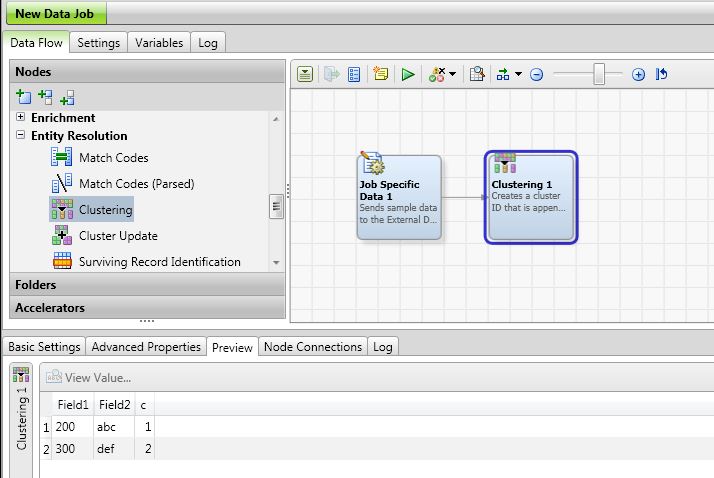
- Mark as New
- Bookmark
- Subscribe
- Mute
- RSS Feed
- Permalink
- Report Inappropriate Content
Hi skillman,
Thanks for your reply,the method you suggested me i was aware of it.But my requirement is from all clusters i need to extract single row clusters into one target table and multirow clusters into another target table.
your inputs highly appreciated,
Thanks in advance
- Mark as New
- Bookmark
- Subscribe
- Mute
- RSS Feed
- Permalink
- Report Inappropriate Content
Sandeep,
In the Cluster you will want to click on options and select the condition matched field prefix. In the screenshots provided I set this field to 'match_'. This node will append the cluster condition number to the field name. I have only one cluster condition, so the output contains only one additional column named 'match_1'.
Then you will need to branch the data and filter it based on the value in match_1. True or False depending if there are matches or not to other records.
The expressions are either:
`match_1` == false
or
`match_1` == true
Then follow the expression with an Insert into the Target table.
-shawn

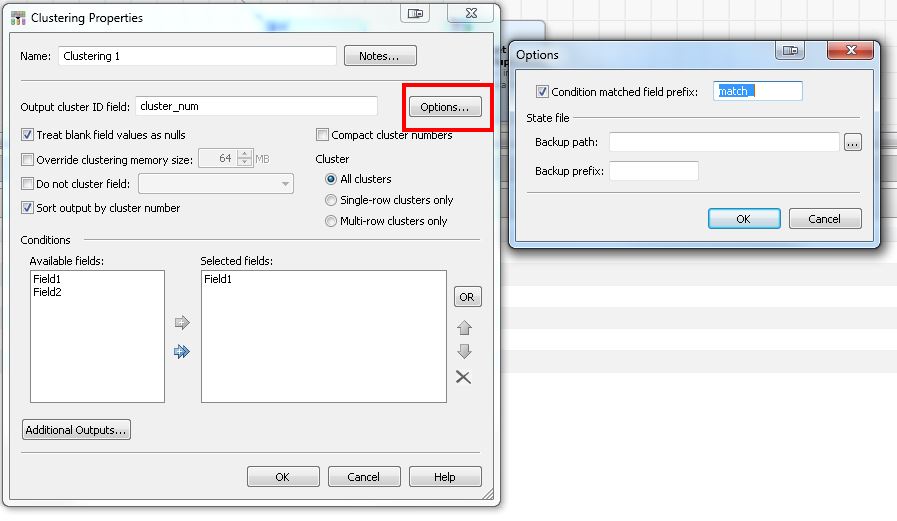
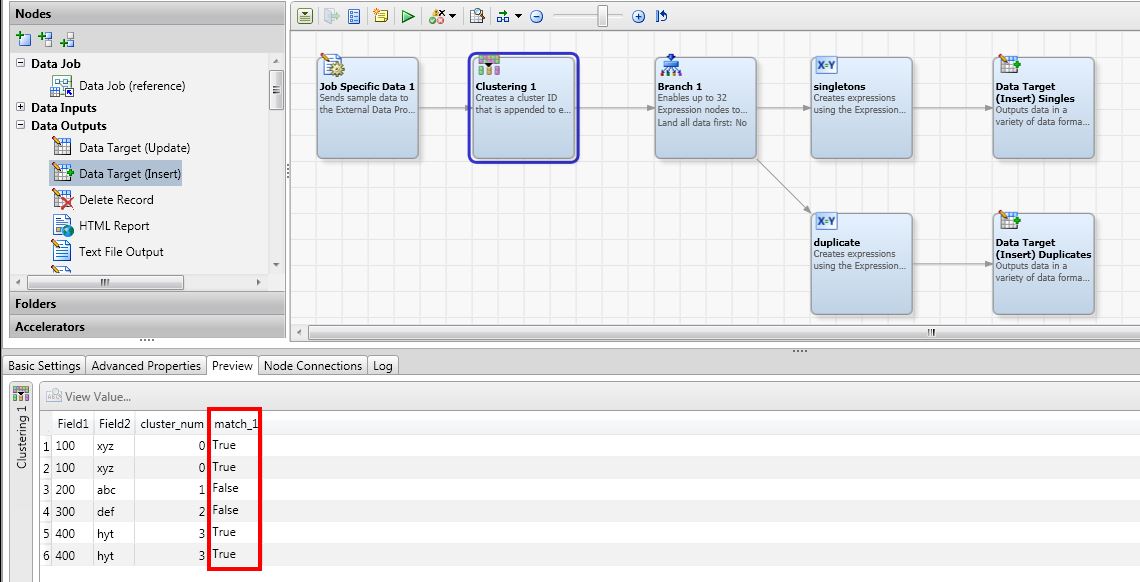
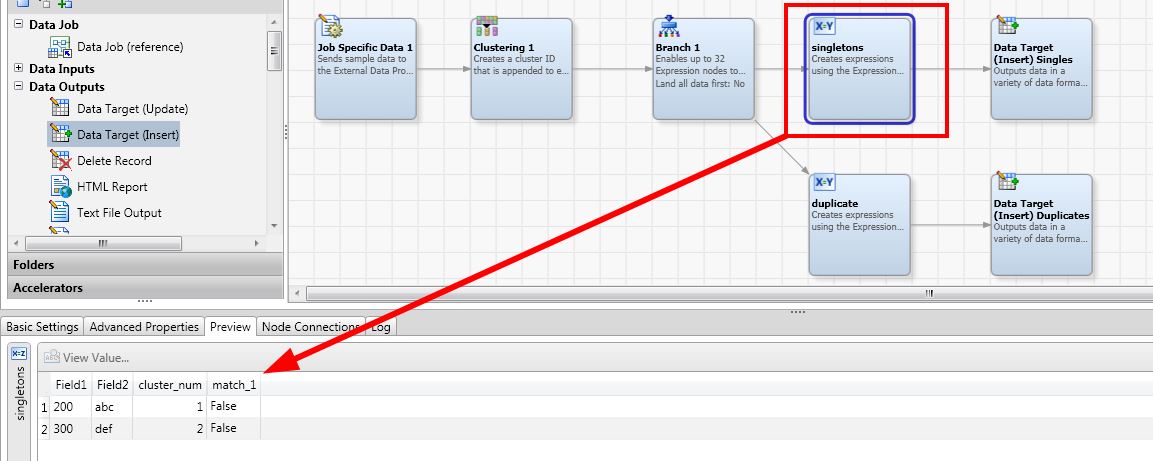
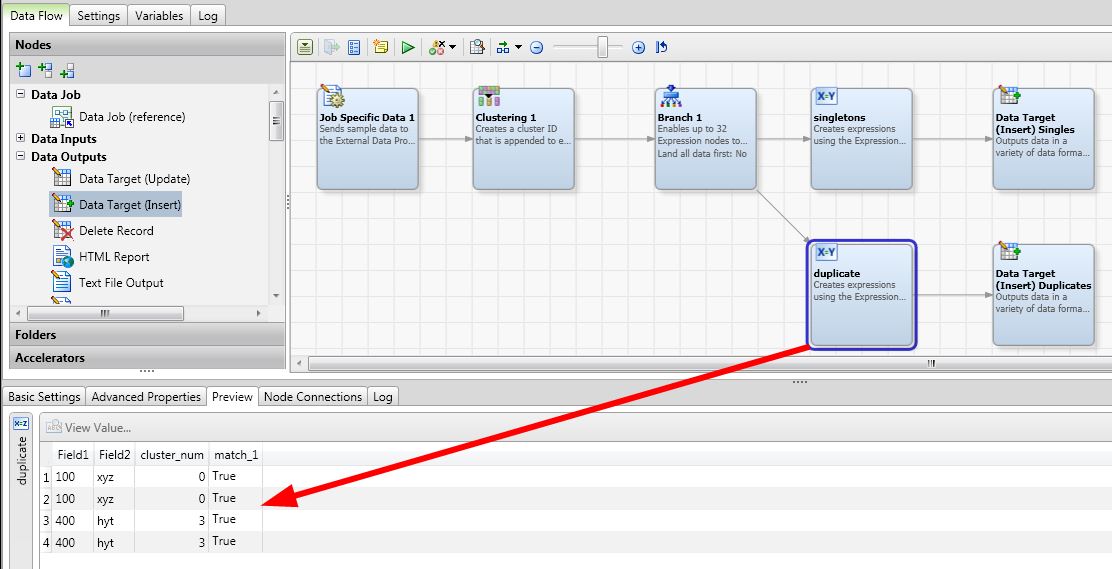
- Mark as New
- Bookmark
- Subscribe
- Mute
- RSS Feed
- Permalink
- Report Inappropriate Content
Hi skillman,
I am working with sas data management studio.I got a requirement like this.Thge records which are matching with given input need to be shown in output.For example if i just enter smith as input it should retrieve the records having smith,smithy,smithi,smit.I used external data provider and sql lookup to look in the database table.Kindly anyone help on this or this can be done in any way.
Your help is highly appreciated.
Thanks in advance
- Mark as New
- Bookmark
- Subscribe
- Mute
- RSS Feed
- Permalink
- Report Inappropriate Content
First you need to add match codes to your database lookup table (the one that the SQL Lookup node references). Create name match codes and insert them into this table. Then when you are testing with the external data provider node, add a match code node for the name (using the same definition and sensitivity as you used in appending match codes to your lookup table.). When you are testing perform the SQL lookup on the match codes and not on the exact names. The following records will return when you enter smith - smithi, SMITH, SmItH, simithe, etc.
-shawn
- Mark as New
- Bookmark
- Subscribe
- Mute
- RSS Feed
- Permalink
- Report Inappropriate Content
The DM Studio 2.5 user guide covers the basics of using the dmexec command, which can be used in a scheduler: Running Jobs from the Command Line
- Mark as New
- Bookmark
- Subscribe
- Mute
- RSS Feed
- Permalink
- Report Inappropriate Content
It is also worth checking to see if the SAS-supplied LSF scheduler has been provided as part of your SAS server installation. The nice thing about the LSF scheduler is that scheduled jobs can be set up from within SAS Management Console.
April 27 – 30 | Gaylord Texan | Grapevine, Texas
Registration is open
Walk in ready to learn. Walk out ready to deliver. This is the data and AI conference you can't afford to miss.
Register now and lock in 2025 pricing—just $495!
Need to connect to databases in SAS Viya? SAS’ David Ghan shows you two methods – via SAS/ACCESS LIBNAME and SAS Data Connector SASLIBS – in this video.
Find more tutorials on the SAS Users YouTube channel.





